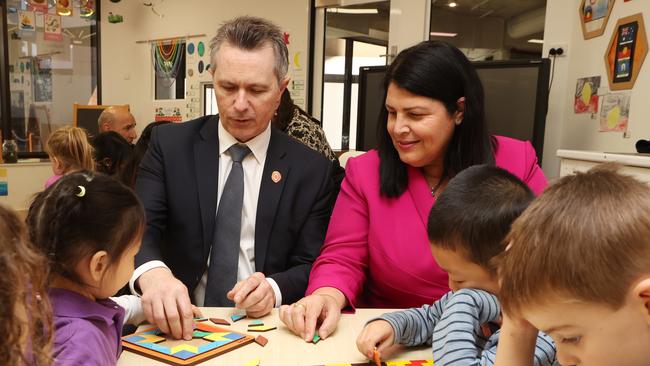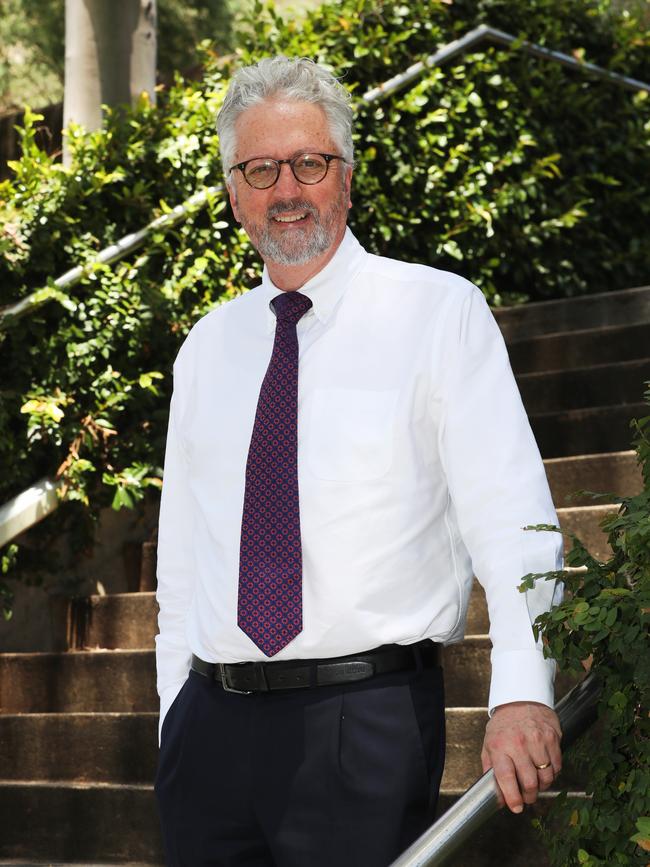Universities Accord to drag academic institutions into the real world
University boffins will now need to collaborate with industry bosses to design ‘degree apprenticeships’. The ivory towers, it seems, are destined for a political demolition job.

Squeals of protest could be heard from ivory towers when the nation’s education ministers mandated the core content for teaching degrees last week.
Their political intervention in academe sets a precedent for the Albanese government’s once-in-a-generation reform of universities, the Universities Accord.
Concerned that too many teachers are graduating from university without the skills and knowledge to teach children and control classrooms, education ministers have given universities two years to fix their initial teacher education degrees. Greater emphasis on practical teaching skills, such as phonics-based reading instruction, will be combined with extra practicum work experience in classrooms.
The political dictation of core teaching standards, driven by federal Education Minister Jason Clare and supported by every state and territory education minister, did not go down well with some academics. Loretta Bowshall-Freeman, a long-time lecturer in education at Flinders University, declared that external controls were “undermining the teaching profession”.
“The commonwealth government … is using teacher-quality for its own agenda – the economic needs of the government,’’ she said. “(This is) not in line with knowledgeable and experienced ITE academic understandings, where universities uphold the integrity of the professional experience placement not through endless policy implementations and mandated guidelines but through philosophical underpinnings of ontological and epistemological positions.”
Back in the real world, education ministers are alarmed that one in every five students is starting high school with the reading and mathematical ability of a child in year 4. Half of all trainee teachers are dropping out of their degrees, exacerbating a post-pandemic teacher shortage that is sabotaging children’s learning and worsening workplace stress in schools.
The ministerial intervention was based on a review led by University of Sydney vice-chancellor Mark Scott, a former schoolteacher and head of the NSW Education Department. Trainee teachers told him their degrees were too focused on educational philosophies and essay writing, leaving them unprepared for the realities of modern classrooms. They wanted to be taught the fundamental skills of planning lessons and assessing students, the sequential and evidence-based teaching of literacy and numeracy, and to understand children’s brain development and behaviour.
After four years at university, why can’t they teach?
All universities should brace for similar public scrutiny as the Albanese government unveils the initial recommendations of its Universities Accord on Wednesday.
The Accord will force greater collaboration between universities and industry to ensure that degrees stay relevant in a fast-changing world shaped by new technologies, artificial intelligence and societal shifts.
The Accord also will recommend changes to the dog’s breakfast of tertiary education funding, as well as reforms to improve the quality of teaching, the relevance of research and academic integrity.
Clare’s mission is to ensure that a university education does not become the privilege of private school kids living in the cities. He wants to make it affordable and accessible to more Australians from poor households, those living in remote and regional areas, Aboriginal people and Torres Strait Islanders.
The Accord will set a long-term target to lift the proportion of young Australians with a university degree higher than the existing rate of 41.5 per cent. It will recommend a modern transformation of traditional degrees, combining them with on-the-job training or slicing them into short “micro-credentials” for existing workers needing to upskill for existing jobs or re-skill for new careers.
As autonomous institutions, universities straddle the worlds of commerce, charities and government. Headed by vice-chancellors pocketing million-dollar salaries, the nation’s 43 universities educated 1.6 million students and employed 129,000 academics, researchers and other staff last year. Taxpayers funded half their running costs, providing nearly $20bn of the $39bn in university revenues in 2021.
Before the Covid-19 pandemic struck, universities enjoyed rivers of revenue from international students paying full tuition fees. But pandemic border closures plunged universities into financial pain – only half the international students have returned, while many domestic students are swapping study for work. Most institutions are bleeding red ink. International student shortages and falling investments led to operating deficits for seven of the eight universities in Victoria last year, while 10 universities in NSW bled $1bn and Queensland’s seven universities lost $1.3bn last year. Queensland’s Auditor-General warned that rising living costs were forcing more students to defer or drop university studies – an ill omen for universities across the country.
Victoria University Online exposed the desperation for enrolments this week when it issued a press release promoting “postgraduate degrees for the price of an iPhone”. “Uni fees slashed by up to 82 per cent in critical fields,” it proclaimed in a highly unorthodox method of marketing the taxpayer subsidies for tertiary courses. The university is offering an “82 per cent saving” for a graduate certificate in nursing, now just $2064 for an online course offered part-time across eight months.

A tough task for the Accord panel – led by science and engineering professor Mary O’Kane and including Australia’s highest paid executive, Macquarie Group chief executive Shemara Wikramanayake – will be to sort through the hotchpotch of tertiary education funding. Taxpayers subsidise university courses through a commonwealth supported place set at a different amount for each degree.
The former Coalition government tried but failed to steer students away from popular degrees in law, business and creative arts through its Job-ready Graduates reform, which cut the CSP for those courses, while increasing the subsidy for degrees in “national priority” areas of teaching, engineering and mathematics. As a result, taxpayers contribute $1100 a year for a management and commerce degree, leaving students with a bill of $14,500 a year. But for teaching, mathematics or clinical psychology degrees, taxpayers contribute $13,250 a year while students pay only $3950 a year.
The financial carrot-and-stick policy has failed, in part, because students do not feel the immediate hip-pocket pain of paying for their degree. They can borrow their tuition fees through government-backed loans and worry about repaying them once they start work. This FEE-HELP system of student loans, previously known as the Higher Education Contribution Scheme, was introduced by the former Hawke Labor government in 1989 when it abolished Gough Whitlam’s legacy of free university. During the past year, spiralling high inflation has created a “debt bomb” for graduates that threatens to blow up in the federal government’s lap.
Graduates pay back the loans through a tax levy once they start earning $51,550 a year – barely more than the minimum wage. But the outstanding balance grows in line with inflation – resulting in a $1500 increase to the average $25,000 debt this year after indexation jumped to 7.1 per cent. Rising levels of unpaid student debt are making it harder for young graduates to buy a home, as banks take their outstanding HELP debt into account when assessing home loans, car loans or credit cards. Worryingly, it is turning more young Australians off the idea of post-school study.
The cost barriers to tertiary study are outlined by the Australian Industry Group, which is pushing for a modern model of “degree apprenticeships” so university students can be earn while they learn. It has warned the Accord review that the “opportunity cost” of full-time university study is locking many Australians out of a university degree.
“For a four-year degree, this could amount to more than $200,000 in wages not earned, with an added cost of a FEE-HELP (Higher Education Loan Program) debt of more than $20,000,” it told the Accord panel. “Not everyone can support themselves with part-time work while studying.”

Engineers Australia, too, has told the Accord panel of the “pain point” for students who cannot afford to study full-time – a trend exacerbated by rising living costs. Many engineering students are taking more than a decade to finish their degrees because they need to work part-time to pay the rent. Barely a quarter finish their degrees in the minimum time of four years. “Unlike other qualifications which can be done more online, engineering requires greater hands-on experiences,” EA told the Accord panel. “Due to this, engineering students are often unable to undertake full-time study. A higher-apprenticeship model affords one option of paid employment/income during periods of internship and study.”
The nursing and teaching sectors, too, have warned that requirements for students to do unpaid practicum placements, often for months at a time, are forcing some to drop out of study. Nurses, for example, are required to complete 800 hours of unpaid work placements, usually in hospitals, as part of their degree. “Students are expected to take time off from paid employment during PEP (professional experience placements),” the National Nursing and Midwifery Education Advisory Network has told the Accord panel. “The realities of not earning a wage while on placement impacts student welfare and ability to complete education programs.”
The need to earn while learning is recognised by the Ai Group, which represents 60,000 businesses employing one million workers. It wants to formalise paid work and study partnerships between employers and universities.
Under its concept of “degree apprenticeships”, universities would work with business to design and deliver teaching content, jointly assess students and award credentials. Industry also wants greater research collaborations, so university boffins and business bosses can cross-pollinate new ideas and work together to solve problems.

“Universities need to understand how industry and different companies operate,” the Ai Group says in its submission to the Accord panel. “More universities, and more staff within universities, need to reach out. Universities would benefit from outreach staff who can meet with businesses to establish their needs.”
Tertiary education, however, has been infected by elitism, with vocational training too often regarded as a consolation prize for school-leavers. Describing Australia’s two-tiered tertiary education system as “deeply and structurally flawed and no longer fit for the future”, the Ai Group has criticised the demarcation between universities and vocational training, including the technical and further education sector.
“This continues to hinder students in their efforts to acquire the combination of knowledge and skills they need for work,” it told the Accord inquiry. “Any attempts to combine skills-based and knowledge-based learning means ad hoc ‘work arounds’ and dealing with multiple providers who do not speak each other’s language.”
Clare is working in lock-step with federal Skills and Training Minister Brendan O’Connor, who tells Inquirer that universities, private training and TAFE colleges and industry must all collaborate to improve workers’ digital skills, rebuild manufacturing and meet rising demand in the care sectors.
“To meet these challenges we need to close the divide between university and vocational education,” O’Connor says. “We need students and apprentices to gain both conceptual knowledge and technical skills, rather than making a binary choice between one or the other. A binary choice between vocational education for a university pathway is outdated.”
Ivory towers, it seems, are destined for a political demolition job.








To join the conversation, please log in. Don't have an account? Register
Join the conversation, you are commenting as Logout